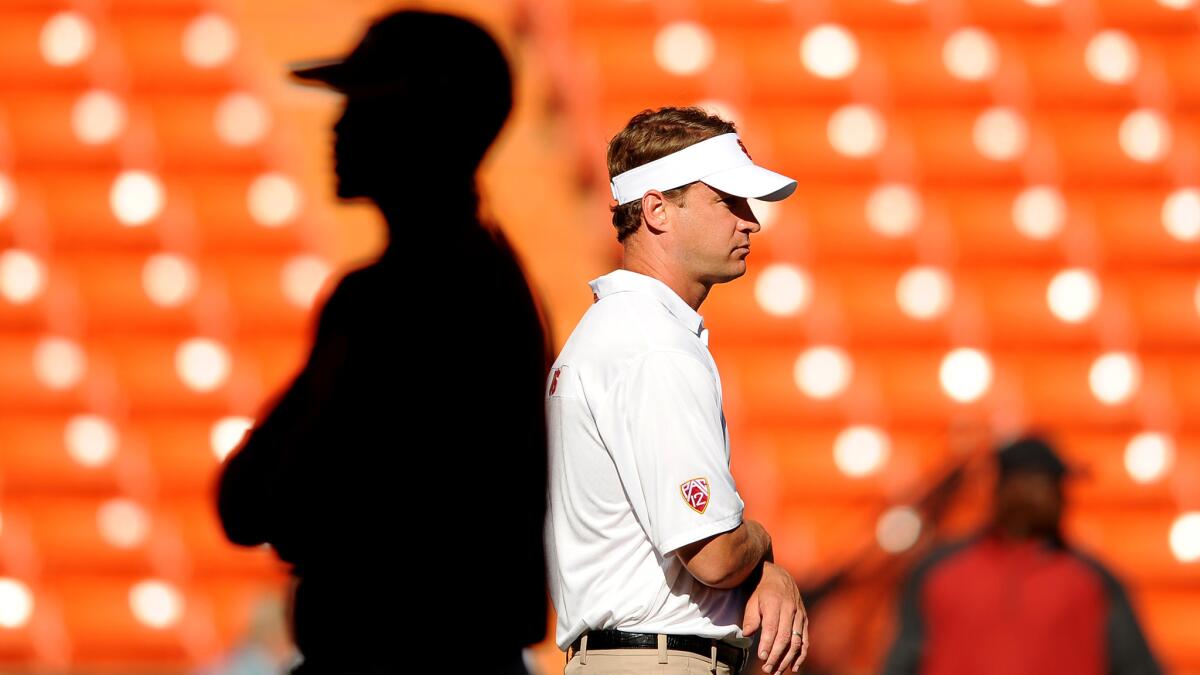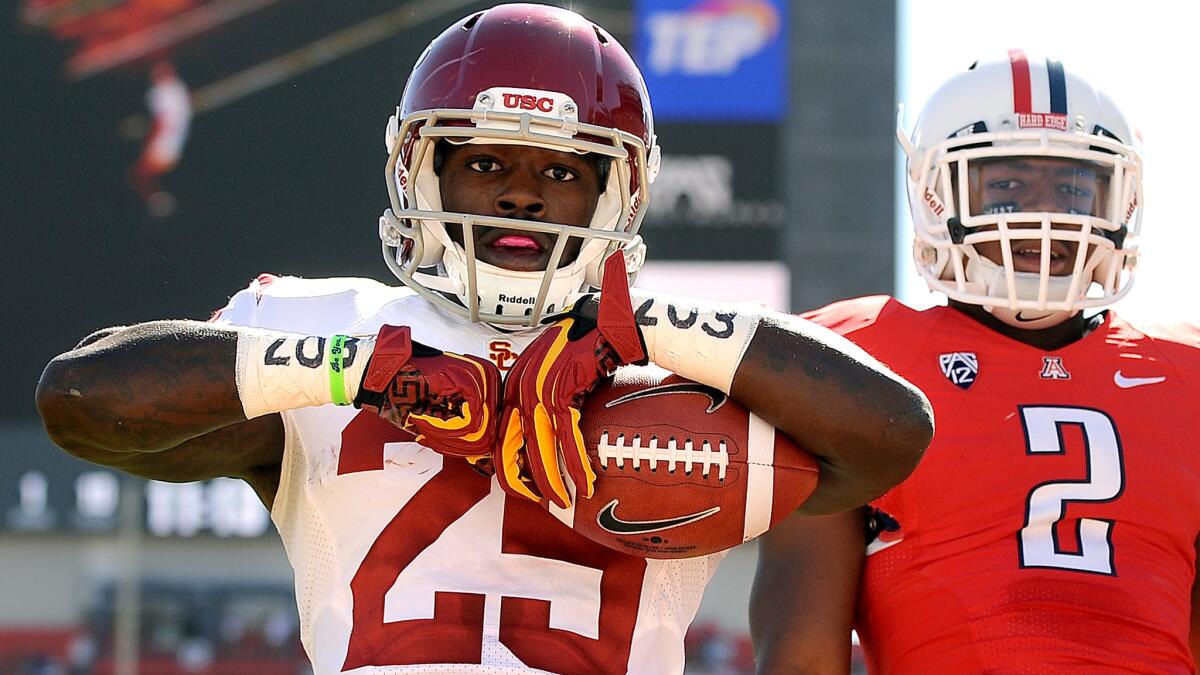Rose Bowl participants USC and Penn State have both rebounded from harsh NCAA penalties

When Penn State’s players were eligible to be recruited in the wake of NCAA sanctions, then-USC coach Lane Kiffin was at the ready.
- Share via
Aboard a Gulfstream 200 high above a green expanse of Pennsylvania, USC Coach Lane Kiffin and his entourage of assistants traced a path not far from Beaver Stadium, where Penn State plays its football games.
It was July 25, 2012, and an unusual connection had formed between the football programs of Penn State and USC. Both were proud. Both, within two years, had been slapped with some of the harshest NCAA sanctions in history.
Penn State’s penalties had been announced two days earlier and Kiffin and USC were poised to take advantage.
Trojans coaches were headed to Connecticut to meet Penn State’s best offensive player, running back Silas Redd. The NCAA, in an unprecedented move, had allowed opposing schools to recruit Penn State’s current players, and Redd was the one Kiffin wanted to poach.
Early the next morning, Kiffin and five assistants met at a Dunkin’ Donuts to polish a painstakingly rehearsed pitch. At 9 a.m., over muffins, Kiffin launched into the presentation. The coaches didn’t finish lobbying Redd for another three hours. Within a week, Redd announced he was transferring to USC.
The courting of Redd was the only direct skirmish between programs in similarly dire straits. In 2010, USC had been saddled with penalties that included a two-year postseason ban and the loss of 30 scholarships over three years, after the NCAA found that Reggie Bush and his family had received cash and perks from sports marketers while the Heisman Trophy-winning running back was playing for the Trojans.
Penn State was dealing with its own sanctions, including a $60-million fine, the vacating of 112 wins, a four-year postseason ban and the loss of 40 scholarships over four seasons — penalties that were later reduced — as part of a child sexual abuse scandal involving former assistant coach Jerry Sandusky.
Each program navigated the fallout differently. USC chose caution and heavy planning. Penn State scrambled to keep its program from collapsing during one frantic week and throughout a longer court battle.
The sanctions have ended for each program, but their effects linger even as the Trojans and Nittany Lions prepare to meet in one of college football’s most storied events, the Rose Bowl.
The matchup is a surprise for reasons beyond what happened on the field during September, when USC was 1-3 and Penn State 2-2.
A binder and a plan
In the summer of 2010, after the NCAA announced USC’s penalties, Kiffin met with Pat Haden, USC’s incoming athletic director, and thumped a thick binder onto the table.
This was Kiffin’s master plan, which he hoped would cover contingencies large and small. Attracting recruits would be more difficult, so Kiffin added a perk: a program that allowed players to graduate in three years. Depth would be thinned, so he proposed shortening practices. The plan drilled into specifics: recruiting a punter and kicker must be a top immediate priority, Kiffin advised. The staff couldn’t afford to waste scholarships on specialists when the reductions hit.
The plan also included Kiffin’s most important suggestion. USC had decided against suing the NCAA, but Kiffin requested that the university file an appeal. There were two motives: the Trojans wanted the sanctions rolled back, but, barring that, the appeal would buy time.
Kiffin, along with senior associate athletic director J.K. McKay, had initiated a study of past recruiting classes. They calculated that, of the 30 lost scholarships, at least five would have gone to “great” players — potential first-round picks. An additional five to seven probably would have been starters.
“And not only are you not getting them,” McKay lamented, “but they’re going across town and they’re playing for your rivals.”

They figured the penalties would reverberate through the program for seven years.
“But I think in all honesty, these sanctions were so unprecedented, we had no idea what was going to happen,” McKay said.
Instead of moving past the sanctions as quickly as possible, Kiffin determined that USC needed to establish a beachhead of talent. The appeal allowed the Trojans to load up their 2011 recruiting class.
USC landed several key players that year, including receiver Marqise Lee, quarterback Cody Kessler and defensive tackle Antwaun Woods.
That type of safe, developed player became the model. Tee Martin, who helped recruit two of the three affected classes and is now the Trojans’ offensive coordinator, recalled that USC had to change the way it recruited.
“You couldn’t miss,” he said. “You couldn’t redshirt and develop a lot of guys that quite honestly needed to be redshirted and developed. You had to come in and play. So you passed up great players.”
The problem was depth more than talent. Many anchors of this season’s Rose Bowl team were successfully recruited during the sanctions, including cornerback Adoree’ Jackson, tackles Zach Banner and Chad Wheeler and receiver JuJu Smith-Schuster
“I just saw an opportunity to play early,” Smith-Schuster said recently.
The lack of depth put a cap on USC’s potential, but the top layer of talent kept the Trojans afloat. Since the scholarship reductions began, USC has won two more games — and lost one fewer — than UCLA. (Some members of the athletic department kept tally.)
The Trojans were taken down a few notches, but the penalties weren’t a death sentence either.
Two-pronged defense
On July 24, 2012, the day after the NCAA President Mark Emmert announced Penn State’s penalties, fullback Mike Zordich and his roommate, linebacker Mike Mauti, woke up and went directly to the office of strength coach Craig Fitzgerald.
Together, they began writing names on a legal pad. On the left side of the page — the “gone” column — they listed players they expected to flee to other teams. The list grew terrifyingly long.
“The immediate concern was losing the entire team by lunch,” said author John U. Bacon, who embedded with the program and chronicled the meeting and Penn State’s team-saving week in his book “Fourth and Long.”
If even half the names on the list left, Bacon said, Penn State would have had difficulties just running a practice.
“I told our administration we may lose this whole team.” then-coach Bill O’Brien recently told the Houston Chronicle.
When the trio completed the list, they approached O’Brien and set about trying to save their team. Together, they worked through the list systematically, knocking on doors, calling players, families and girlfriends.
O’Brien wanted to give the players a deadline by which they had to decide. Zordich told his coach he thought that was a bad idea. Players would panic, he said. Mauti agreed. O’Brien was new on the job and just getting to know Zordich and Mauti, but he took their advice.
O’Brien pitched team members on earning their degree and experiencing a season unlike any other. Just one week after Matui and Zordich wrote their list, O’Brien convened a gathering of about 500 former Penn State letter winners, who spoke about what it meant to play in the program.
The patience and persistence worked. Redd transferred, but only eight others, including one who left for unrelated personal reasons, followed.
Amid this existential crisis, O’Brien also had a stunned recruiting class he needed to salvage. The jewel was a quarterback from Fork Union Military Academy in Virginia, Christian Hackenberg, and O’Brien kept in close contact, gaining his trust.
Hackenberg was at a quarterbacks showcase in Huntington Beach when he met with reporters and announced nothing had changed.
“At the end of the day, if there’s football at Penn State, I’m going to be there,” he said.
Hackenberg, who is in his rookie season with the New York Jets, was “the guy who made it OK to go to Penn State,” said Brandon Huffman, national director of recruiting for Scout.com. “You have that Pied Piper guy, that top-tier quarterback who’s a national name sticking with them. And that allowed other guys to follow.”
Penn State ended the week having avoided a football disaster. But with years of scholarship losses looming, the worst of it might have only been delayed. To stave that off, supporters went to the courts.
In January 2013, Jake Corman, a Pennsylvania state senator whose district includes Penn State, sued the NCAA. The scope of the lawsuit was limited to one provision of the sanctions. The NCAA planned to allocate Penn State’s $60-million fine to programs working to treat and prevent child sexual abuse around the country. The lawsuit sought to keep the money in Pennsylvania.
But during arguments, the NCAA made a mistake in a legal maneuver that made its entire package of penalties vulnerable.
In January 2015, Corman and the NCAA settled. The $60 million would remain in Pennsylvania. Former coach Joe Paterno’s victories would be restored. Four months earlier, under mounting pressure, the NCAA had already restored Penn State scholarships (it lost 15 total, over two seasons) and rescinded the bowl ban.
The new normal
Penn State Coach James Franklin keeps a chart on his desk that he can reference whenever he is feeling frustrated. It shows Penn State’s scholarship chart, which, if put on a teeter-totter, would tip over to the left, where the underclassmen are listed.
The lost scholarships “really affected us,” Franklin said of this season. “Depending on how you look at it, which analytics company you use, we’re like the sixth-youngest team in the country.”
Franklin, in his third season at Penn State since O’Brien left to coach the NFL’s Houston Texans, has called this “year one.” He noted the team is still thin at multiple positions. For example, a spate of injuries compelled the Nittany Lions to use their fifth-team middle linebacker at one point this season.
USC’s roster is similarly uneven. Its junior and senior classes are still depleted, and the Trojans’ youth was exposed early — of their three losses, none came at home, including one, at Utah, in which theysquandered a late lead.
Where might USC be had its roster been more experienced? Coach Clay Helton has deflected such questions during Rose Bowl practice.
“I think,” he said, six years after the sanctions were announced, “we’re getting back to normalcy.”
Follow Zach Helfand on Twitter @zhelfand
Go beyond the scoreboard
Get the latest on L.A.'s teams in the daily Sports Report newsletter.
You may occasionally receive promotional content from the Los Angeles Times.




